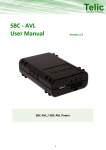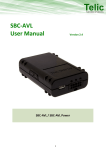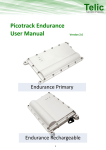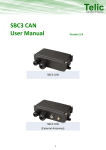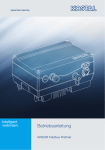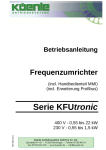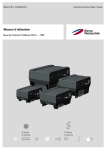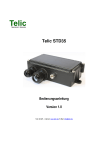Download Picotrack User Manual Version 2.3
Transcript
dfdfdsf Picotrack User Manual Version 2.3 Picotrack Picotrack IP69K Picotrack Power 1 dfdfdsf Table of Contents 1 Introduction ______________________________________________________________________ 4 2 Delivery content ___________________________________________________________________ 5 3 Technical Data ____________________________________________________________________ 6 4 Operation Setup ___________________________________________________________________ 7 5 6 7 4.1 Opening the device ____________________________________________________________________ 7 4.2 Inserting the SIM Card __________________________________________________________________ 7 4.3 Closing the housing ____________________________________________________________________ 8 4.4 Switching the device ON and OFF _________________________________________________________ 9 4.5 Status Indicators _____________________________________________________________________ 10 Troubleshooting hints _____________________________________________________________ 11 5.1 The device doesn’t show any sign of life __________________________________________________ 11 5.2 The device doesn’t log into the GSM network ______________________________________________ 11 5.3 The device doesn’t log into the GPRS network _____________________________________________ 12 5.4 The device doesn’t send messages _______________________________________________________ 12 5.5 The device doesn’t receive GPS data _____________________________________________________ 12 Basic Features ___________________________________________________________________ 13 6.1 Event Types _________________________________________________________________________ 13 6.2 Connection Establishment Procedure_____________________________________________________ 13 6.3 Event Message Structure_______________________________________________________________ 13 Advanced Features________________________________________________________________ 15 7.1 Geofencing __________________________________________________________________________ 15 7.2 Roaming alternative configuration _______________________________________________________ 15 7.3 Device Watchdogs ____________________________________________________________________ 15 7.4 Device-based wireless positioning _______________________________________________________ 15 8 Device Installation on Board ________________________________________________________ 16 9 Safety __________________________________________________________________________ 17 9.1 General Battery handling ______________________________________________________________ 17 9.2 Battery storage ______________________________________________________________________ 17 9.3 Battery Disposal ______________________________________________________________________ 18 10 General Terms and Conditions ______________________________________________________ 19 11 Compliance Statements ____________________________________________________________ 20 11.1 CE Declaration of Conformity ___________________________________________________________ 20 12 Document History ________________________________________________________________ 21 2 dfdfdsf Table Overview Table 1: Accessories List ................................................................................................................................... 5 Table 2: Technical Data ..................................................................................................................................... 6 Table 3: Status indicators ............................................................................................................................... 10 Table 4: The device doesn’t show any sign of life .......................................................................................... 11 Table 5: The device doesn’t log into the GSM network ................................................................................. 11 Table 6: The device doesn’t log into the GPRS network ................................................................................ 12 Table 7: The device doesn’t send messages ................................................................................................... 12 Table 8: The device doesn’t receive GPS data ................................................................................................ 12 Table 9: Content Description .......................................................................................................................... 14 Table 10: Document History ........................................................................................................................... 21 Figure Overview Figure 1: How to open the device .................................................................................................................... 7 Figure 2: How to inserting the SIM Card .......................................................................................................... 8 Figure 3: Switch the device off ......................................................................................................................... 9 Figure 4: Geofencing ....................................................................................................................................... 15 3 dfdfdsf 1 Introduction The Picotrack is small sized tracking device which is well suited for tracking valuable goods and shipments. The Picotrack is suited for a wide range of asset tracking applications including the following (this list is not exhaustive!): Tracking of valuable goods and shipments (Product prototypes, cash transport, high value products) Tracking product packaging (e.g. pallets & crates…) Mobile industrial equipment Because of the multitude of possible application we cannot list them all. Therefore we will only refer to installation scenarios as they occur in asset tracking applications. The Picotrack device is available in the following versions: Picotrack: For all applications where smallest dimensions are essential and there is the possibility to frequently recharge the device. Picotrack Power: Just 1 mm thicker than the standard Picotrack. It is suited for all applications where the smallest dimensions are essential and a longer battery lifetime is required. Picotrack IP69K: The Picotrack Power is provided inside an IP69K grade casing, which is can also be supplied with a magnet (as optional accessory) for quick installation on metallic surfaces. It is suited for all applications where long battery lifetime is needed and the device is subjected to harsh environmental conditions. 4 dfdfdsf 2 Delivery content The standard delivery includes the Picotrack device. The delivery could include furthermore some of the following accessories, depending on the details of your purchase order: Accessory Name Order code Functionality USB-A / MicroUSB-B-Cable 17005 Use this cable only to charge the device (but not for configuring it). Cable for ConfigTool Picotrack 16207 User this cable to charge or to configure the device via the Telic Config-Tool Picotrack power supply w/o USBcable 17003 Use this power adapter to connect the device to a mains supply. Picotrack Cigarette lighter charger w/o USB-cable 17004 This cable allows to connect the device to a cigarette lighter Magnet plates for Picotrack IP69K 17020 Used for installation on metallic surfaces Table 1: Accessories List 5 Picture dfdfdsf 3 Technical Data The following table lists key technical parameters for the products: Components Dimensions Connectors Environmental Rating Status LEDs GSM/GPRS module GPS Sensitivity (Tracking) GPS Acquisition Time GPS Tracking / Acquisition Channels Battery Message Logging Capacity Picotrack Picotrack Power Picotrack IP69K 57x38x15 mm 57x38x19 mm 95x50x39 mm Charging cable N/A N/A IP69k protected 3 indicators for the states: GSM, GPS, On/Off, battery charging/full, DOTA, On/Off button… Quadband-GSM-Module at 850 MHz / 900 MHz / 1800 MHz / 1900 MHz. -165 dBm Cold ~ 34sec ; Warm ~ 33 sec ; Hot < 1 sec 22/66 channel 660 mA/h 1320 mA/h 2800 Sleep mode average consumption (GPS+GSM off) GSM/GPS antennas Operating Temperature Recharging Temperature Supply voltage Weight Certificates 1320 mA/h 0,07 mA Both integrated -20°C to +60°C 0°C to +45°C 5V USB 40 g 5V USB 50 g CE, ROHS Table 2: Technical Data 6 5V USB 100 g dfdfdsf 4 Operation Setup The operation set-up of the Picotrack device can be realised in few quick steps. Please take proper measures for ESD protection (e.g. electrical connection of the body to ground) to make sure you do not destroy internal electronics! Repair of ESD damages caused by user’s negligence will not be covered by Telic’s warranty. Electrostatic discharge (ESD) is the sudden and momentary electric current that flows between two objects at different electrical potentials normally caused by static electricity. 4.1 Opening the device Open Picotrack housing by screwing off the housing (as shown in the following Figure). The SIM card holder is under the battery and allows to slide-in and to fix a standard Mini-SIM card. Be careful when moving the battery not to pinch the battery cable. Figure 1: How to open the device 4.2 Inserting the SIM Card A working SIM card from a suitable network provider must be correctly inserted in order for the device to operate correctly. The messages of the Picotrack are transmitted via the mobile GSM network. Therefore you need a standard 3 Volts or 1.8 Volts SIM card. Please give preference to post-paid SIM cards! Please put the device in front of you on your desk so that you can slide-in the SIM card (as shown in the following Figure); the gold contacts of the SIM card must be facing down. The SIM card must be pushed in the direction of the arrow, until it snaps into place. 7 dfdfdsf Figure 2: How to inserting the SIM Card The opposite cover of the housing, in which the GPS receiver is embedded, should not be opened, to avoid a contamination of the receiver which may lead to a reduction of receiving quality (should you be forced to clean the pad sometime, please do so using pure alcohol). Before the Picotrack logs into the mobile GSM network, it checks whether the used SIM card is PIN free. If it is PIN free, it will start normal operation. If the SIM card is not PIN free, it has to be assured, that the PIN is set to “0000” before it has been inserted. The PIN can be changed e.g. with a normal GSM mobile phone to “0000”. To speed up the log-in into the GSM network, the SIM card should not contain any phone book entries. 4.3 Closing the housing Make sure that the battery is not damaged or squeezed by the holder of the housing while closing the device, and that the battery cable is not pinched or kinked. Avoid any stress on the micro USB connector when it is plugged in the Picotrack. In the worst case, the connector of the Picotrack board could be damaged. Telic’s warranty does not cover the repair of this type of damage. Close the device again and take care that the housing covers fit together tightly and properly. 8 dfdfdsf 4.4 Switching the device ON and OFF Telic delivers the devices switched OFF. To switch the device ON: push the red button until the green LED of the left GSM-indicator lights up. To switch the device OFF: device push the red button twice in quick succession. Note that the green LED of the left GSM indicator will continue to light-up for a while, even though the switch-off process is on its way. Figure 3: Switch the device off Pushing the red button will always be confirmed by the red LED in the centre indicator, which means it will be illuminated as long as the button is being pushed. 9 dfdfdsf 4.5 Status Indicators Internally the device has three status indicators each indicator has 2 or 3 different colored LEDs closed grouped together. Middle Indicator: Power supply Left indicator: GSM status Right Indicator: GPS status status The left indicator reflects the GSM status and also, whether the device is switched on. The middle indicator reflects the status of the integrated battery as well as of the DOTA download. The right indicator reflects GPS reception as well as the device reset status. When the LED is off, the device is switched off The middle LED being off does NOT mean that the device is switched off. It only indicates that the device is not connected to external power supply. Off: GPS is not switched on Permanently on: switched on, but network is available. Permanently on: the device has external power supply and the battery is fully charged. 2 times blinking: 2D- Fix (no valid height and the position may be imprecise GSM is no GSM Blinking once: the device is logged into the GSM network. 3 times blinking: 3D (GPS data are complete Blinking twice: TCP/IP connection to the server has been established Permanently on: the battery is currently charging. 1 time blinking: position acquisition not possible The middle indicator works identically if the device is in sleep mode; just the left and the right indicators are off. Slow double blinking: the SIM card is not readable (e.g. if not correctly inserted into the SIM cardholder or others). The red LED is permanently on during the whole DOTA (Download Over The Air) procedure. After a certain period of time the Picotrack will switch-off completely (as it would be after pushing twice the red on/off button). Table 3: Status indicators 10 About 5 seconds red during device reset dfdfdsf 5 Troubleshooting hints 5.1 The device doesn’t show any sign of life Possible issue source The device is not switched on Trouble shooting Press once the red on/off button to turn the device on. Table 4: The device doesn’t show any sign of life 5.2 The device doesn’t log into the GSM network Possible issue source Trouble shooting The device isn’t in a GSM covered area Please check whether there is GSM reception in this area (e.g. using a cell phone) and move eventually to another area. The position of the Picotrack device is not favourable. Choose another place in the vehicle which might be less shielded. The SIM card in the Picotrack device is new and has not yet been activated Please check, whether the SIM card is already activated. This can be done e.g. by putting the SIM card into your cell phone and checking, whether your cell phone is able to log into a GSM network. The SIM card has been locked by the provider Please check whether the SIM card is locked. This can be done e.g. by putting the SIM card into your cell phone and checking, whether your cell phone is able to log into a GSM network. If this not the case, then please try to make a phone call. If you are successful, the SIM card is definitely not locked. The prepaid bonus is exhausted Please recharge the SIM card in the Picotrack device. The prepaid SIM card is no longer valid If they aren’t recharged on a regular basis (often after 12 or 24 months). In this case usually you have to buy a new SIM card. The PIN code of the card has not been deactivated or is not set to “0000” Please remove the SIM card from the device and check the PIN code. The Pin code has to be deactivated or set to “0000” After a triple wrong entry of the PIN, unblocking the SIM card requires the PUK. The SIM card hasn’t been inserted into the SIM card holder in the correct way Please check the correct position of the SIM card in the card holder. Table 5: The device doesn’t log into the GSM network 11 dfdfdsf 5.3 The device doesn’t log into the GPRS network Possible issue source Trouble shooting The GPRS service is not yet Please ask your provider, whether the GPRS function is already activated activated for the SIM card in use. Table 6: The device doesn’t log into the GPRS network 5.4 The device doesn’t send messages Possible issue source Trouble shooting Battery of the device was Please recharge the device and wait for 3D GPS fix to completely drained (e.g. after synchronise the internal real time clock. several weeks of storage) Table 7: The device doesn’t send messages 5.5 The device doesn’t receive GPS data Possible issue source Trouble shooting The position of the device is Please check, whether the device has the indicators facing up not favourable for the GPS and a clear view of the sky. reception The GPS receiver has no free Please be aware, that a GPS receiver operates most efficiently sight to the sky when there is a clear view of the sky. Please ensure that the device side with the LEDs has free view to the sky. Your asset is placed in an Please consider that a GPS reception operates most efficiently unsuitable location when there is a free view of the sky. If GPS reception is not available (e.g. due to location of the asset inside a warehouse), considering using the Device-based Wireless Positioning feature as an alternative positioning method (see Section 7.4). Table 8: The device doesn’t receive GPS data Further hints regarding sources of errors are indicated through the 8 LEDs of the 3 indicators, which are easily visible from outside. You will find details of the meaning of the different colours and blinking signs in Section 0 (“ 12 dfdfdsf Status Indicators”). 13 dfdfdsf 6 Basic Features The device can be configured either via serial cable by using the Telic Configuration tool or remotely via SMS and GPRS. Please contact the Telic support team to receive more details about the configuration procedure. 6.1 Event Types The Picotrack’s primary task is to transmit GPS positioning data as well as additional status information via a TCP/IP connection to the tracking server. If a message can’t be transmitted, it will be stored in the device for transmission at a later point in time. There is a storage capacity of about 1.000 position messages. The following events will generate a positioning message which always contains the GPS position: 6.2 Time event: the end of a time period of x seconds (x being configurable). Distance Event: after a distance of x meters (straight line distance to the previous event) in any direction (x being configurable) has been travelled. Angular change Event: a direction change of a configurable minimum angle in x degrees (x being configured) at a configurable minimum speed of y km/h (y being configurable). Power event: Switching on or off the device. Connection Establishment Procedure The GSM and GPS modules will power up after switching on the Picotrack device. After logging in into the GSM network the Picotrack will attempt to establish a GPRS communication link. Finally a TCP/IP connection to the tracking server will be established to transmit the event messages. The selection of the GSM network operator will take about 1 minute, plus the time to build up the GPRS- and TCP/IP-connections to the tracking server. Therefore, after switching on the device, it will take approximately 2-3 minutes until the first status message can be transmitted. Independent of this procedure, GPS positions and status information will be generated and stored in the internal memory for later transmission. Here follows the message structure: 6.3 Event Message Structure The first identified and valid GPS position will be taken as the reference position for the distance interval calculations. The next distance interval event will be generated if the configured distance has been reached. If another event (e.g. time interval event) has been generated before, the distance interval measurement starts again at the position of this new event. That means that any position message with an actual GPS position sets a new reference for the distance interval calculations. This reduces the number of messages sent while still keeping the desired resolution of the tracking application. A position message will also be generated in the case of a direction change being greater than the configured angle while travelling at the configured minimum speed. Switching on and off the external Power supply (e.g. ignition on/off) also leads to an event message. The last valid position will be transmitted when no new valid GPS position is available. 14 dfdfdsf Content Description Event/Log –Code Reason for the status message Event/Log Timestamp Time at which the event has happened GPS Timestamp GPS timestamp at the moment of fetching longitude and latitude Longitude Degree of longitude (default: in 100µ degrees; can be decreased to 1µ degrees precision) Latitude Degree of latitude (default: in 100µ degrees; can be decreased to 1µ degrees precision) Fix Type 1,2 or 3, depending on the availability of satellites in view having a sufficient signal strength: 1D Fix (no valid data) 2D Fix (no height indication) 3D Fix (position message with height indication) 6 (GSM Tracking; must be activated in the device) Speed over ground Speed in km/h Satellites for calculation Actual number of satellites which are used for calculation Height Height above sea level (in m) Mileage Mileage in meters DigIns 4 digits e.g. 0010, if charger is connected Analog Input 1 Value of the analogue input 1, i.e. Battery voltage with a precision of 1/10 volts MotSens Status of the motion sensor Table 9: Content Description 15 dfdfdsf 7 Advanced Features This section describes some advanced features supported by the device, which might be required for different use cases. 7.1 Geofencing Geofencing (an electronic safety fence) provides the opportunity to set a geographic square around a defined location. Here you can configure different events like “leaving the area” or “entering the area” to be transmitted to the control centre. Up to 50 geofence areas can be monitored, which can also be combined to create larger areas and build up complex protection zones. Every geofence area is given an Area ID, a centre (defined by its longitude and latitude) and a height and width (from the centre not completely across) in meters. Figure 4: Geofencing 7.2 Roaming alternative configuration The device is able to detect a GSM roaming status and swap automatically to an alternative setup for roaming (this alternative setup has to be previously configured). This allows optimizing the data traffic and reducing the communication costs. 7.3 Device Watchdogs The Picotrack has different integrated watchdogs. They automatically check the functions of the device and generate resets as soon as they recognise any malfunction. Malfunction could occur due to internal problems of the device, problems related to the GSM connection, problems with the GPS reception and many more. This watchdog concept ensures that the Picotrack can automatically return to stable operation if necessary. Control of the watchdogs by the user is not necessary. If the watchdog has to restart the device it may happen that some of the position messages and respectively events are not logged and as a result they are not transmitted to the tracking server. 7.4 Device-based wireless positioning The device can be configured in order to get a localization obtained by the GSM module, in case that the GPS has some difficulties providing a valid fix. Of course this position will be less accurate and take a bit longer than the standard way by GPS module, therefore this functionality has to be considered as a fallback for the GPS. 16 dfdfdsf 8 Device Installation on Board In order to protect your goods from theft and vandalism the device should be installed in a location where it is well-hidden. Please install the device in a suitable, dry location, not in contact to radio and audio frequency interference or hot parts of the good. Be aware to observe ESD (Electro Static Discharge) protection measures. When installing the device consider that antennas are integrated, this means it must be installed in a place with a minimum distance of 7 cm within a minimum 180 ° cone of the patch antenna to any metallic components of the good in each direction. In order to optimize the quality of the signal received, the surface of the internal GPS internal antenna must be installed skywards. The unit can also be placed on the lateral side of the Asset or even below it if the optimal installation described above is not possible. Consider, though, that this might have the following effects: Reduction of the device’s battery life time due to the GPS module requiring more time and higher power consumption to get a fix. Less precise fix. The accuracy of the fix might be affected by reflections of the GPS signals. It is advisable to configure in such cases the unit to perform 2D fixes. No fix possible. In this case, it is possible to get a rough position by device-based GSM tracking, but the battery lifetime of the unit will also be adversely affected. 17 dfdfdsf 9 Safety The following guidelines must be followed in order to ensure the safety of users. If these rules are ignored Telic will not assume responsibility for any damages that are incurred. 9.1 General Battery handling The Picotrack main power source is a battery with high energy capacity. These rechargeable batteries are designed to provide the highest possible degree of safety. They may, however, present a potential hazard if they are abused electrically or mechanically. This is in most circumstances associated with the generation of excessive heat. In this case the internal pressure may cause the cell case to rupture. Consequently, the following general guidelines should be followed when handling the Picotrack Battery: Do not short-circuit Do not over discharge Do not incinerate Do not expose to temperatures beyond the specified temperature range Do not crush or puncture Do not open cells, do not disassemble battery packs Do not expose contents to water Do not connect with false polarity Do not weld or solder to the battery’s body It is very important that only authorized official Telic replacement batteries be used in the Picotrack. Also the batteries included with the devices are only tested or authorized for use in the Picotrack. The batteries should never be used in any other devices unless specifically authorized by Telic, including but not limited to other Telic products or devices. 9.2 Battery storage Batteries should be stored in rooms with generally low temperature and low humidity levels. While it is not essential that these storage areas be temperature and humidity controlled, temperatures should generally be kept below 35 °C and storage areas should be well ventilated. Storage temperatures above 75 °C should be avoided. Your Picotrack batteries should be stored in their original packaging materials or in the Picotrack itself. This will eliminate unintentional short-circuiting. Do not store batteries in conductive antistatic bags or foam unless the resistivity of the material exceeds 1 MΩ. Batteries should not be placed on or covered with metallic or otherwise conductive material. Batteries should be stored away from any flammable material in the storage area. Fire extinguishers for metal fire (class D) are preferred. Do not attempt to extinguish fires with small amounts of water, sand, or with carbon dioxide extinguishers. 18 dfdfdsf 9.3 Battery Disposal The disposal or recycling of batteries is regulated by each European country. In each country, the manufacturers, importers and users are responsible for proper disposal. The European Community (EC) has issued two directives, 91/157/EEC and 93/86/EEC. These directives are implemented by each member country of the EC independently and in a different way. In accordance with these directives, the Picotrack batteries do not contain dangerous substances. The reaction products are inorganic and do not represent environmental risks once the decomposition process has terminated. 19 dfdfdsf 10 General Terms and Conditions All information in this documentation has been carefully assembled and checked, but should not be considered as a guaranteed feature set. The copyright of the related documentation is with Telic GmbH. The Telic Logo and the terms Telic, and Telic Picotrack are brands of Telic GmbH. All further names and terms used can be brands or registered brands of their respective owners. Telic reserves the right to change the included information without notice and doesn’t take responsibility for errors in the document and/or missing information. 20 dfdfdsf 11 Compliance Statements 11.1 CE Declaration of Conformity 21 dfdfdsf 12 Document History Revision Date Changes Rev. 2.0 15/03/14 First release on new layout Rev. 2.1 21/05/14 Update Status indicator Rev. 2.2 26/05/14 Update Technical Data Rev 2.3 11/07/14 Update Section 11 Table 10: Document History 22






















